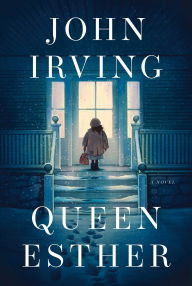Queen Esther: A Guest Post by John Irving
This story about unbreakable bonds, coming-of-age, and the search for home stars Dr. Wilbur Larch — one of John Irving’s most unforgettable characters. Read on for an exclusive essay from John Irving on writing Queen Esther.
Queen Esther: A Novel
Queen Esther: A Novel
By John Irving
In Stock Online
Hardcover
$27.00
$30.00
After forty years, John Irving returns to the world of his bestselling classic novel and Academy Award–winning film, The Cider House Rules, revisiting the orphanage in St. Cloud’s, Maine, where Dr. Wilbur Larch takes in Esther—a Viennese-born Jew whose life is shaped by anti-Semitism.
After forty years, John Irving returns to the world of his bestselling classic novel and Academy Award–winning film, The Cider House Rules, revisiting the orphanage in St. Cloud’s, Maine, where Dr. Wilbur Larch takes in Esther—a Viennese-born Jew whose life is shaped by anti-Semitism.
If you’re familiar with the novel or the film of The Cider House Rules, a character you know reappears in my 16th novel, Queen Esther. Dr. Larch, the obstetrician and abortionist at the orphanage in St. Cloud’s, Maine, is younger than you remember him, and there’s a different cast of characters among the unadopted orphans. Esther is the most unadoptable. A three-year-old who knows she’s Jewish, her life has been shaped by anti-Semitism.
Esther was born in Vienna in 1905. Her mother and father hoped to save their baby from the anti-Semitism that was rising in Austria. Her father died on board the ship from Bremerhaven to Portland, Maine. As Larch learns from a rabbi, Esther’s mother was murdered by anti-Semites in Portland.
When Esther is fourteen, about to become a ward of the state, Dr. Larch meets the Winslows—a family with a philanthropic history of providing for unadopted orphans. Esther’s gratitude to the Winslows is unending. As she retraces her steps to her birth city, Esther keeps loving and protecting the Winslows—even in Vienna.
The final chapter of Queen Esther is set in Jerusalem in 1981, when Esther is seventy-six. I was invited to Israel by the Jerusalem International Book Fair and my Israeli publisher in April 1981. My favorite European publishers were Jewish, with longstanding ties to Israel. They were leftist, nonobservant Jews who criticized the right-wing Likud government of Menachem Begin for accelerating the settlements in the West Bank. They thought the Jewish presence there, and in the Gaza Strip, might make Palestinian self-determination hard to achieve. They said then that a two-state solution for Israel and Palestine could slip away. In April 1981, the seeds were sown for an eternal conflict.
In July 2024, I was back in Jerusalem, refreshing my memory of the visual details—going where I’d gone, forty-three years ago. The war in Gaza was ongoing. In the Muslim Quarter, there were no tourists on the Via Dolorosa—the Way of Sorrows, where Christ carried the cross to be crucified. No tourists in the Christian Quarter (not even at Christ’s tomb, in the Church of the Holy Sepulchre). In the evenings—when my Israeli friends were at anti-Netanyahu protests—I read over the notes I’d written to myself, and I mapped out where I would go the next day.
A historical novel foreshadows the future. Queen Esther ends in Jerusalem in 1981. The dialogue in my last chapter mirrors what was said to me, or what I know I overheard. In a historical novel, the dialogue must also be what was commonly said at that time and in that place.
Both in her hiddenness, and in the decisive way she reveals herself, my Esther is an empathetic embodiment of the Esther in the Hebrew Bible and the Christian Old Testament. The character of Jimmy Winslow is a truthful exaggeration of myself. Both in Vienna in 1963-64, and in Jerusalem in 1981, Jimmy is even more unaware than I was.
